With modern technology, marketers and brands hold a wealth of information at their fingertips when it comes to measuring the success of their advertising campaigns. Although not traditional and relatively new, measuring a Fake Out of Home or FOOH ad success is no exception.
After all, if you do it right, FOOH ads can be a powerful tool in any marketer's toolbox. It can bring you a whopping number of impressions and engagement and get people talking about your brand.
But what exactly is a FOOH ad? And, how do you know if your FOOH ad campaign is delivering the results you want? This guide will explore 29 essential metrics and tips to help you measure and improve your FOOH ad success. Let's take a look.
Want to know everything there is to know about Fake Out of Home ads? Check our 2024 guide here.

Fake Out of Home, or FOOH, is a type of short-form video advertising that combines CG 3D elements with real-life footage of popular locations and landmarks. You'll often see these ads on TikTok, Instagram or Meta reels, and YouTube dhorts.
When done right, Fake Out of Home ads (when done right) create such a seamless blend of the real and the 3D elements that you'll often see a barrage of online comments asking, "Chat, is this real?"(It's not.) Sometimes, the disbelief and absurdity are so out of this world that even news outlets will pick up on these ads, not realizing it's a marketing ploy.
Just take a look at this FOOH ad from Volvo Austria. A car is being driven out of an underground freeway, where it appears in a garage that seems to be installed on the wall of a second-story building. People were asking our team at Rendersnek how long this installation would be up in Vienna!
Another similar thing happened with our FOOH ad for Vapiano Austria. A marketing department from another company actually called Vapiano and inquired how much it would cost to hang the noodles on a building's facade—as if it were a real thing.
Got a question about Fake Out of Home ads or have an idea you want to pitch? Contact us and let's make it happen.
The absurdity and shock factor these ads can create makes them so effective. They stop people in their scrolling tracks, getting them to pause and engage with the content. And big brands are well aware of this, too, which is why you've seen them jumping on the hype train and seeing FOOH ad success in recent years.
Fake Out of Home is the future of advertising, and here are 5 top reasons why this trend is here to stay and why you should care if you're a marketer or advertiser.

Marketing campaigns take work, and marketers and brands know that. From its conception to the execution of each ad, every piece is carefully curated to fit the brand's specific purpose and goal. And planning your campaign and FOOH ad success are no different.
Before launching your FOOH campaign, it is crucial to identify your primary objectives and how FOOH ad success is supposed to look for your business. Do you want to raise brand awareness? Increase social media engagement and followers? Or generate leads for your business?
Once you've set what you want to achieve, it's time to make those goals SMART. Specific, Measurable, Achievable, Relevant, and Time-bound. For example:

KPIs are essential for measuring the success of any marketing campaign. They help you understand what's working and what needs improvement in your campaign, which is crucial for measuring FOOH ad success. KPIs also provide valuable insights into your target audience and their behavior, giving you the information you need to optimize your campaign for better performance.
Depending on which platform you use for your FOOH ads, some of the metrics will be available to measure directly from the platform's analytics dashboard. For others, you may need to use third-party tools or manual calculations to track these metrics.
Here are 16 key metrics that you should consider when measuring FOOH ad success:
The lead generation rate is the percentage of people who view your ad and take action. This could mean clicking a unique link to your website or filling out a form.
Tracking leads generated from your ad is an excellent way to measure the FOOH ad success in generating potential customers for your business. Because this metric is more specific to your business goals, it can give you a better understanding of the impact of your FOOH ad campaign.
Apart from lead generation, you should also track the overall conversion rate of your FOOH ad. This measures the percentage of viewers who take a desired action, such as making a purchase or signing up for a service.
Here's an example: If your marketing campaign's goal received 100 new leads, but none of them converted into customers, then it may be time to tweak your ad. Your FOOH ad may have received interest, but its message may haven't resonated with your target audience.
Want to know what makes a FOOH ad successful? Read our: 5 Top Tips on Avoiding Common Fake Out of Home Ad Mistakes to learn more.
The cost per lead is the amount of money you spend to generate one lead. For example, if your FOOH ad campaign costs $100 and generates 50 leads, then your cost per lead is $2. This metric helps you determine the efficiency of your marketing efforts and can guide future budget allocations.
Another important metric to consider when measuring FOOH ad success, the CPA is the average cost you spend to acquire a new customer. This includes all the costs associated with your FOOH campaign, including ad creation, ad placement fees, and additional expenses. A lower CPA indicates higher efficiency in acquiring new customers through your marketing efforts.
Engagement is a crucial aspect of FOOH ad success. The more people talk about your ad, the better its reach and potential impact.
Tracking likes, shares, and comments on social media platforms like TikTok, Meta, and Instagram can show how well your ad resonates with your viewers and target audience. This metric can also help you identify any changes or updates that could improve the engagement on your FOOH ad.
How many people watch your entire FOOH ad? Do people skip it after a few seconds, or do they watch until the end?
Tracking your video completion rate can give you insight into how effective the content of your FOOH ad is. If your completion rate is low, meaning people aren't watching your whole ad, that can tell you that your hook might be strong, but your ad's middle, end, and overall message may need improvement.
Here's a guide on How to make effective and viral FOOH ads that sell.
Simply put, the CTR is the percentage of viewers who clicked on your ad. This metric can show how well your FOOH ad persuades people to take action, whether it's to visit your website or download an app.
How many people are talking about your brand after seeing your FOOH ad? Tracking mentions and hashtags related to your ad will let you know how well it's resonating with viewers and if it's creating any sort of dialogue or conversation online.
Unique reach refers to the number of individuals who saw your ad at least once. This metric can show how many people were exposed to your brand through your FOOH ad campaign.
Similar to unique reach, impressions measure the total number of times your ad was shown, including multiple views by the same person. This metric is useful for understanding the overall exposure and potential impact of the FOOH ad success.
Knowing how many people visited your website after seeing your FOOH ad can give you an idea of its effectiveness in driving traffic, especially if your goal is to increase brand awareness and website visits.
You can track this using unique links or landing pages specific to your ad campaign. This will also help you identify which platforms or channels drive the most traffic to your website.
The bounce rate measures the percentage of people leaving your website after viewing only one page. A high bounce rate could indicate that your FOOH ad isn't effectively targeting the right audience or that your website needs improvement.
Knowing where your website traffic is coming from can help you determine if your FOOH ad is effectively reaching your desired audience. If a huge portion of your traffic isn't coming from social media -- where your ad is placed, it may be time to rethink the messaging or content of your FOOH ad.
Tracking this metric means examining the number of times your brand was mentioned before and after the launch of your FOOH ad campaign. This could include social media mentions and tags, articles, news stories that feature your brand, or customer feedback.
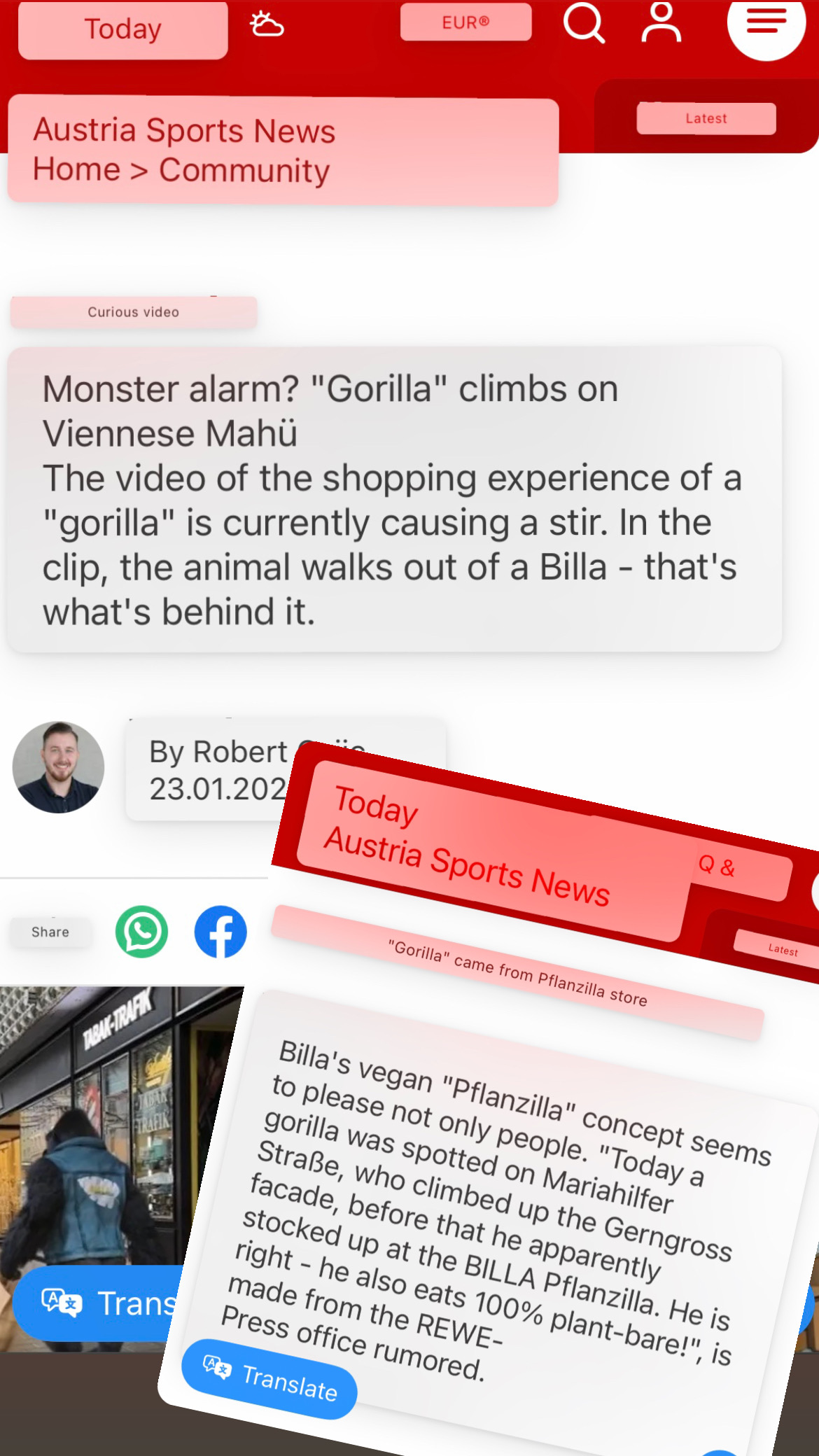
Brand sentiment refers to people's overall attitude towards your brand. Look at the comments and feedback on your FOOH ad to understand how people perceive your brand.
How do people respond to your ad? Are they excited, intrigued, or uninterested? This metric will help you gain insights into how the FOOH ad success is impacting brand perception and if it aligns with your overall branding strategy.
This metric measures the number of people searching for your brand, another critical indicator of FOOH ad success. This metric is worth tracking if your top goal is to increase brand awareness and recognition.
You can track branded search volume through Google Trends or other analytics tools and compare it to the time period before your FOOH ad campaign. An increase in branded searches suggests that your ad has successfully increased brand awareness among your target audience.

Knowing the right tools to track your KPIs is crucial in measuring FOOH ad success. You can make informed decisions and adjustments to your campaign based on data-driven insights, and avoid making calls that could potentially harm your return on investment.
Here are 13 tools you can use to measure your FOOH ad success:
This all-in-one tool is a must-have for tracking website traffic, bounce rate, and traffic sources. The platform offers in-depth data and analytics on website unique visitors, conversions, viewers, and how the FOOH ad success impacts your website's overall traffic.
A great feature of this analytics tool is the ability to set up custom goals and track specific actions that align with your brand and FOOH ad campaign's objectives. For example, if the goal of your campaign is to increase conversions and drive more sales, you can set up a goal for each completed purchase and track the number of conversions from your FOOH ad campaign.
FOOH ads are placed on social media, and Instagram is one, if not the most popular choice of platform for this type of advertising. Using Instagram's built-in insights, you can track how many people saw, liked, commented, shared, or bookmarked your FOOH ad post.
You can also see how many people interact with your profile after they see your ad. If your goal is to increase brand awareness as part of your marketing campiagn, this tool can be valuable in tracking your progress and FOOH ad success.
Another popular option, Meta's ads manager, is a great tool for tracking FOOH ad success on Facebook and Instagram. This is a fantastic tool, especially if your target audience is on Meta, as it offers in-depth data on reach, impressions, CTR, and engagement metrics like comments and shares.
Another useful feature of this tool is the ability to create custom audiences based on location, demographics, interests, behaviors, etc. This allows for better targeting of your FOOH ads to reach the right audience.
TikTok has become an increasingly popular advertising platform, and its short video format aligns perfectly with the nature of FOOH ads. Its analytics dashboard tracks views, likes, shares, comments, and audience demographics for your FOOH ads.
However, it is important to note that if you post your FOOH ad on TikTok, it's not recommended that you do so anywhere else. TikTok's algorithm favors new and unique content, so posting the same ad on multiple platforms may result in lower engagement, so make sure your target audience is primarily on TikTok.
A platform that also allows you to schedule and publish posts, Hootsuite's Analyze feature provides insights into major social media platforms like LinkedIn, X, Meta Pages, YouTube, and Instagram. This tool also offers a unique feature to track FOOH ad success: impact metric.
This metric provides insights into each social media post's return on investment (ROI), including FOOH ads. You can see how much revenue or conversions your ad generated compared to the cost of running it and track the overall impact of your FOOH campaign.
If you're a marketer or agency running a campaign for a client or brand, their feedback is also crucial in evaluating FOOH ad success. After all, they probably know most about their brand, target audience, and goals.
Make sure to communicate regularly with your clients and gather their direct feedback on the FOOH ad sucess. Schedule regular check-ins with your clients to discuss campaign progress, goals, and any concerns they may have.
Your client's satisfaction with the ad campaign will open your eyes to areas for improvement and ultimately lead to success. It also allows for open communication and collaboration between marketer and client, resulting in a stronger partnership and potentially more successful future campaigns together.
Sprout Social offers a comprehensive social media report for your marketing campaign. This platform allows you to compare how your posts are performing to a competition's, and it can also show you if FOOH ad success is on the horizon. It also allows you to view which campaign, whether it's a contest or a promotion of a new line, impacted your brand awareness the most.
Rival IQ is an all-in-one social media analytics software that can compare your performance and your competitors' FOOH ad success rate across multiple platforms, such as Facebook, Twitter, and Instagram. This tool also provides insights into your audience demographics and engagement rates.
Brandwatch is an analytics tool that helps you understand how your brand is perceived online in real-time. This sophisticated platform can track conversations, mentions, sentiment, and overall reach on various social media platforms, blogs, and articles about your FOOH ad.
Brandwatch also offers you key insights into which influencers might be talking about your campaign. This allows you to identify and potentially collaborate with them to increase FOOH ad success in future campaigns.
SEMrush is a marketing analytics tool that tracks your website's performance regarding organic and paid search traffic. You can also use this platform to monitor your competitors' FOOH ad success rate, keywords, and budget for each campaign.
This advanced tool also offers insights into your website's SEO and content strategy, like backlink analysis and keyword rankings. These insights can help you optimize your website for better performance.
Gathering feedback from your target audience is an important aspect of measuring FOOH ad success. SurveyMonkey allows you to design and conduct surveys to gather information on what people think about your ad campaign if it resonated with them, and how it impacted their perception of your brand.
SurveyMonkey also offers a Net Promoter Score (NPS) feature, which measures customer loyalty and satisfaction. This can be valuable in understanding if your FOOH ad campaign effectively increases brand loyalty for your target audience.
Mention is another social listening tool that helps you track brand mentions across various platforms in real time. It can help you monitor the impact of your campaign on social media and overall FOOH ad success, and it allows you to engage with potential customers or address any negative mentions.
This tool also offers insights into sentiment analysis, popular hashtags related to your brand, and geographic location of mentions and compares them to your competitors. These insights can help you make data-driven decisions for future FOOH ad campaigns.
Buzz Sumo is a content marketing tool that helps you analyze your content's performance and identify top-performing topics, keywords, and influencers in your industry. It can also track social media shares related to your FOOH ad campaign, giving you insights into what content resonates with your audience.
This tool also offers competitor analysis and allows for content ideation based on popular trends and keywords related to your niche or industry. These insights can help you create more impactful campaigns and content and guarantee future FOOH ad success.
As the digital landscape continues to evolve, knowing what data to track and how to analyze it is crucial in measuring the FOOH ad success. Even if you don't see success from your numbers right away, these tools and strategies can help you optimize future campaigns for maximum impact.
Constantly measuring and analyzing data can provide valuable insights into your target audience's behavior and preferences, allowing you to create more effective FOOH ad campaigns that resonate with them.
With time, fine-tuning of your campaign, and consistent analytics monitoring, you can stay ahead of the curve and consistently drive success for your FOOH ad campaigns. So, stay informed, stay updated, and keep optimizing to achieve the best possible results.
Got an idea for a FOOH campaign or interested in implementing one for your brand? Connect with us today and let's make it happen.
2023 was quite a year for "Fake Out of Home advertising" or "Fake OOH." This new form of advertising quickly gained traction over the past year, especially among fashion and lifestyle brands, and has been the talk of marketing circles ever since.
FOOH ads have been taking the advertising industry by storm, but what exactly does it mean?
The wording for this new-age marketing has yet to be 100% defined. Mixed Reality Videos, Augmented Reality Videos, Virtual Reality Videos, Fake Ads, CG Ads, and CG Marketing are some of the terms used to describe it.
Essentially, Fake Out of Home is a form of advertising that combines computer-generated imagery (CGI) and real video footage to create an illusion of an immersive, short-form ad that appears as if it is taking place in a real-world location.
These ads are then shared on social media platforms, such as Instagram and TikTok, to reach a larger audience. Let's explore what FOOH ads are and why you should care about them.
Fake OOH advertisements, or as we like to call them, "Mixed Reality Videos," are compositions of real videos with computer-generated imagery (CGI). In summary: putting/tracking 3D objects in a conventional video.
In general, the use of CGI is nothing new; Hollywood has been doing that for quite some time already. In fact, the first feature film to use CGI was "Westworld" (1973), and the first film to ever use CGI was "Vertigo" (1958), a movie by Alfred Hitchcock. It was used in the film's opening credits.
If you want to know more about this new marketing trend, read our 2024 guide on everything you need to know about FOOH.
As you can see, CGI has been around for a long time; most of us just haven't noticed it. So, why is it such a big deal in the world of advertising now?
Fake Out of Home ads offer a unique and innovative way for brands to showcase their products or services. With the rise of social media and short-form content, these ads are perfectly suited to grab the attention of younger audiences constantly scrolling through their feeds.
Here are the top 5 benefits of using FOOH ads for your brand:
FOOH ads are short-form in nature. These ads can quickly rack up millions of views because of their entertainment (and often shock) value. Just look at Maybelline on Instagram, for example. Their typical content gets about 200,000 views on average, but their Fake Out of Home ads easily reach millions of views!
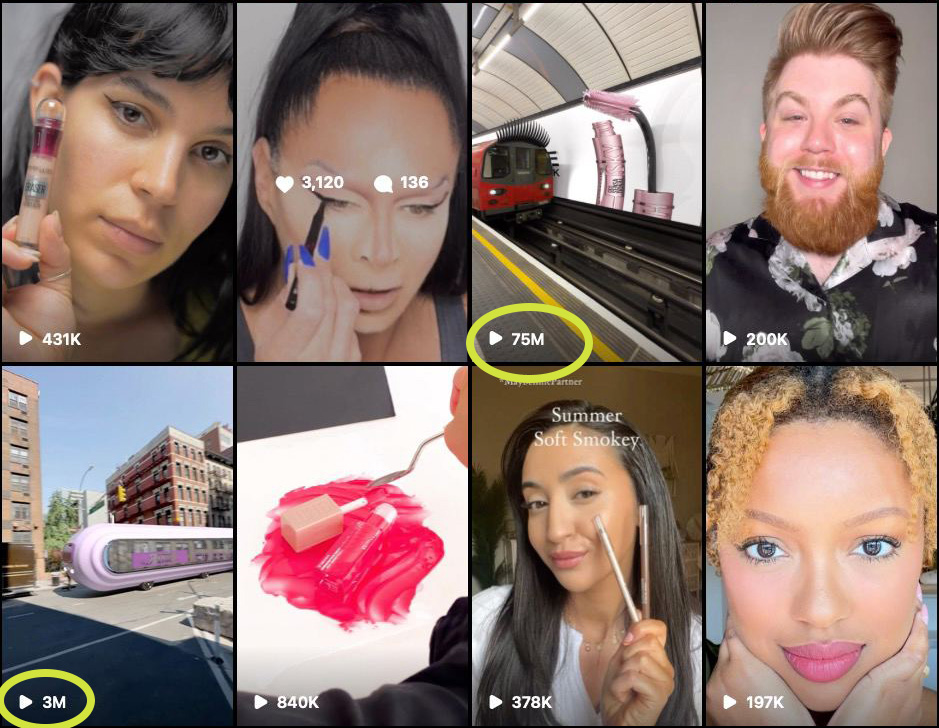
While the 8-minute attention span claim has been debunked (multiple times!), attention is still money. The true claim?[1] Good storytelling keeps people hooked for longer - the same reason people can binge-watch a TV series for hours.
And if showrunners can do that with hours, imagine what brands can do in just seconds!
With CGI or AR technology, the sky (or your budget) is the limit. Want life-sized versions of your products roaming the streets of New York for your campaign? No problem. Want to place a huge clothes line on top of the Statue of Liberty to showcase your new clothing line? Consider it done.
Just look at Jacquemus' Instagram page. It's filled with absurd and unconventional ads that showcase the brand's quirkiness and avant-garde fashion. These types of ads are only possible with Fake OOH technology. And, of course, they get millions of views, too.
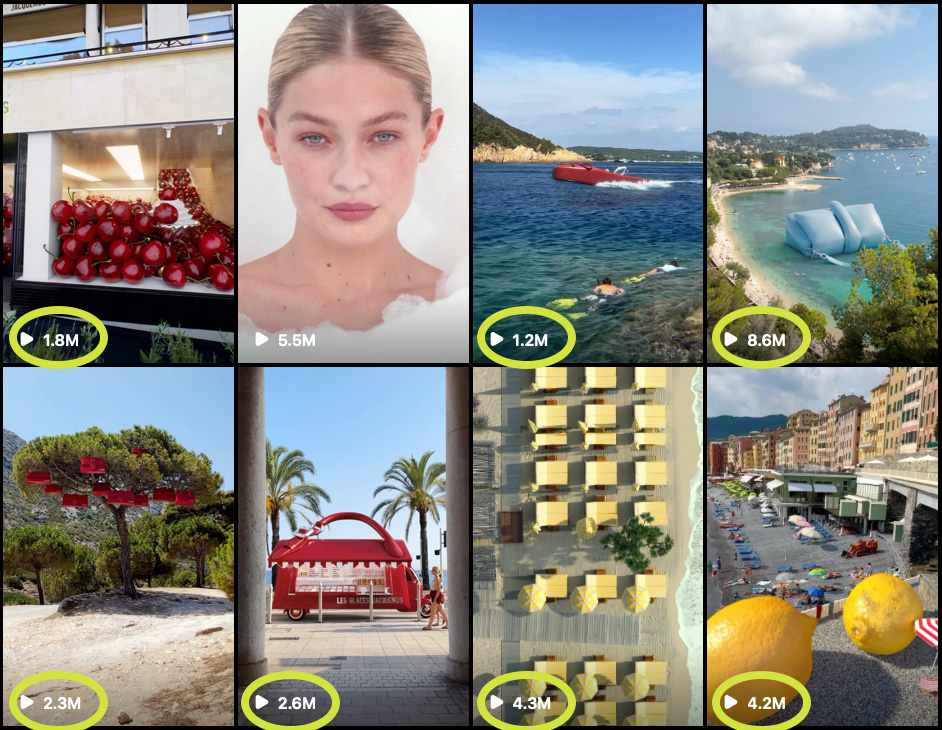
Believe it or not, Fake Out of Home ads are relatively cost-effective compared to traditional out-of-home advertisements such as billboards or bus stop ads. With Fake Out of Home, you don't need to pay for physical space or printing costs; you only need an excellent CGI and video production team.
And with social media platforms offering targeted advertising options, brands can reach their desired audience without spending on expensive billboards that may not even be seen by their target market.
Plus, FOOH ads are a great cost-saving method for testing a new campaign idea or product before investing in a full-scale traditional marketing campaign. Producing a FOOH asset is relatively quick, making it perfect for testing new ideas.
With various short-form content on Instagram Reels, FB shorts, and TikTok competing for views, going viral organically can be challenging. FOOH ads have a wow factor that stays with your viewers, making them more likely to share it with their friends and followers.
Take Alexander Wang's huge FOOH CG installation, for example. It received over 50 million views on Instagram, compared to the hundreds of thousands or several million views of their more normal posts. Going viral means more exposure for your brand and the potential to reach new audiences.
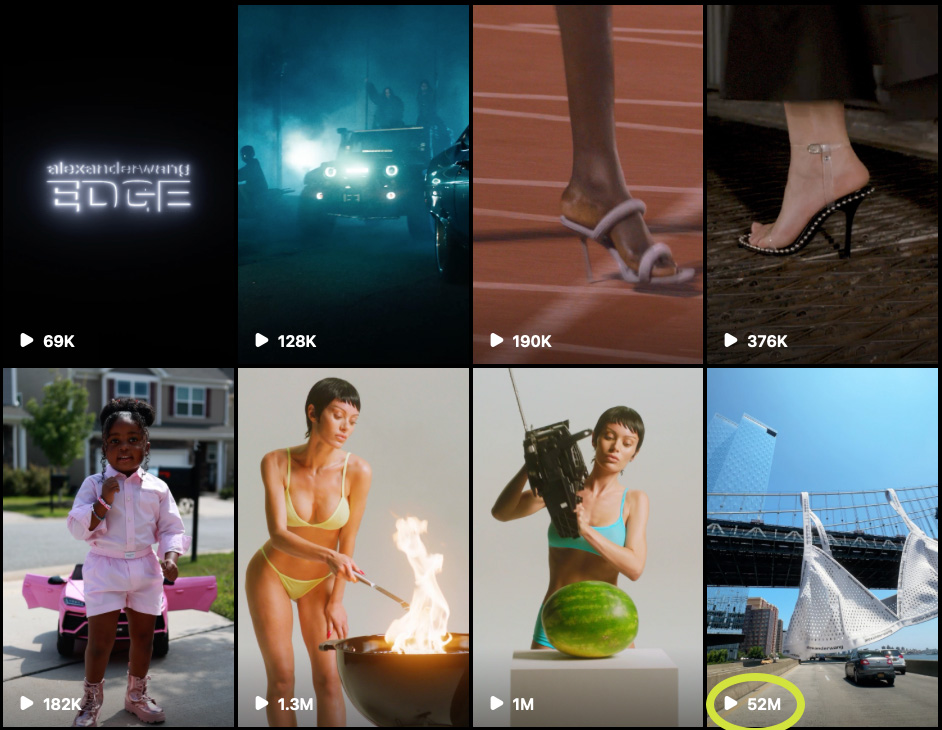
As brands and consumers become more conscious of the impact of consumption on the environment, Fake Out of Home ads offer a more environmentally friendly solution to advertising. With no need for physical materials or space, these ads significantly reduce carbon footprint and waste.
You don't have to fly out your creative team and spend on transportation, accommodations, and production materials to install a physical ad. Plus, with digital tracking and monitoring, brands can easily see the performance of their Fake Out of Home ads in real-time and make adjustments as needed without wasting paper or material.
Your ads also don't need to be reinstalled repeatedly because they were ruined by the weather or vandalized, as it does with more traditional forms of advertising. With the rise of green and sustainable branding, FOOH ads can give your brand a competitive edge.
Fake Out Of Home ads often get negative connotations because of the "Fake" aspect. Some people argue that it's misleading and unethical, while others champion that it's simply a new and creative way for brands to showcase their products.
Another potential consideration is the legality of using certain locations or landmarks in FOOH ads. These ads will often hinge on footage of recognizable locations, and brands must be careful not to infringe on copyrights or trademarks.
You might need to obtain permission or pay licensing fees to use certain locations in your Fake Out Of Home ad campaigns, which is why it's crucial to work with a creative team that truly understands the legalities and best practices of using CGI in advertising.
At rendersnek, we do our homework in researching and obtaining any necessary permissions to ensure your FOOH ads are both effective and ethical. Got a question or an idea? We'd love to hear from you.
FOOH advertising has revolutionized how brands advertise, allowing you to advertise in places where you could never reach before, in ways that traditional advertising could never do. Because of its cost-effectiveness and high-engagement potential, it's no wonder more and more brands are going crazy for this type of advertising and taking a bite out of FOOH pie.
And the numbers don't lie either. FOOH ads have been proven to be more effective in capturing attention and driving engagement than traditional out-of-home forms of advertising. It’s safe to say that this trend is going nowhere and is here to stay, so this is certainly an exciting time for marketers and advertisers to explore the endless possibilities that FOOH ads can offer for their brand.
Our suggestion: Give fake out of home advertisement a try!
In just 2023, Fake Out of Home (FOOH) advertising has become a pivotal element in innovative marketing strategies. This new “mixed reality” take on traditional out-of-home advertising has significantly shifted how brands interact with consumers.
With the world constantly evolving, staying ahead of the curve and understanding the latest trends is essential. We all know out-of-home (OOH) advertising, but what exactly is Fake OOH advertising?
In this guide, we will explore Fake OOH advertising's potential for success in marketing in 2024. From understanding its basics to exploring examples and best practices, this guide will equip you with all the necessary knowledge to help you stay on top of your advertising game.
Contrary to out-of-home (OOH) advertising, which involves the physical placement of ads in public spaces like billboards, bus stops, and digital screens, FOOH advertising is entirely digital. This unique type of advertising is primarily seen on social media platforms such as reels, stories, TikTok, YouTube shorts, and other short-form video content.
It combines actual video footage (often using well-known outdoor locations and sights) with computer-generated 3D elements.
The video below illustrates the process how an FOOH ad is put together.
Other terms often used to describe this type of advertising include virtual out-of-home (VOOH), manipulated out of home videos, and mixed reality videos. These terms highlight the use of technology to create an illusion of physical advertisements in real-world locations.
FOOH ads aim to grab your attention immediately and retain it throughout. This is why the format often incorporates famous landmarks, monuments, and other iconic or recognizable locations, such as the Eiffel Tower or Burj Khalifa, into the base video material.
It should be noted, however, that shooting video footage at these locations can be costly or might require special permits, so it's not as easy as it may seem. This is where the magic of working with a 3D animation team comes into play — as they often incorporate this legal aspect into their work and the services offered.
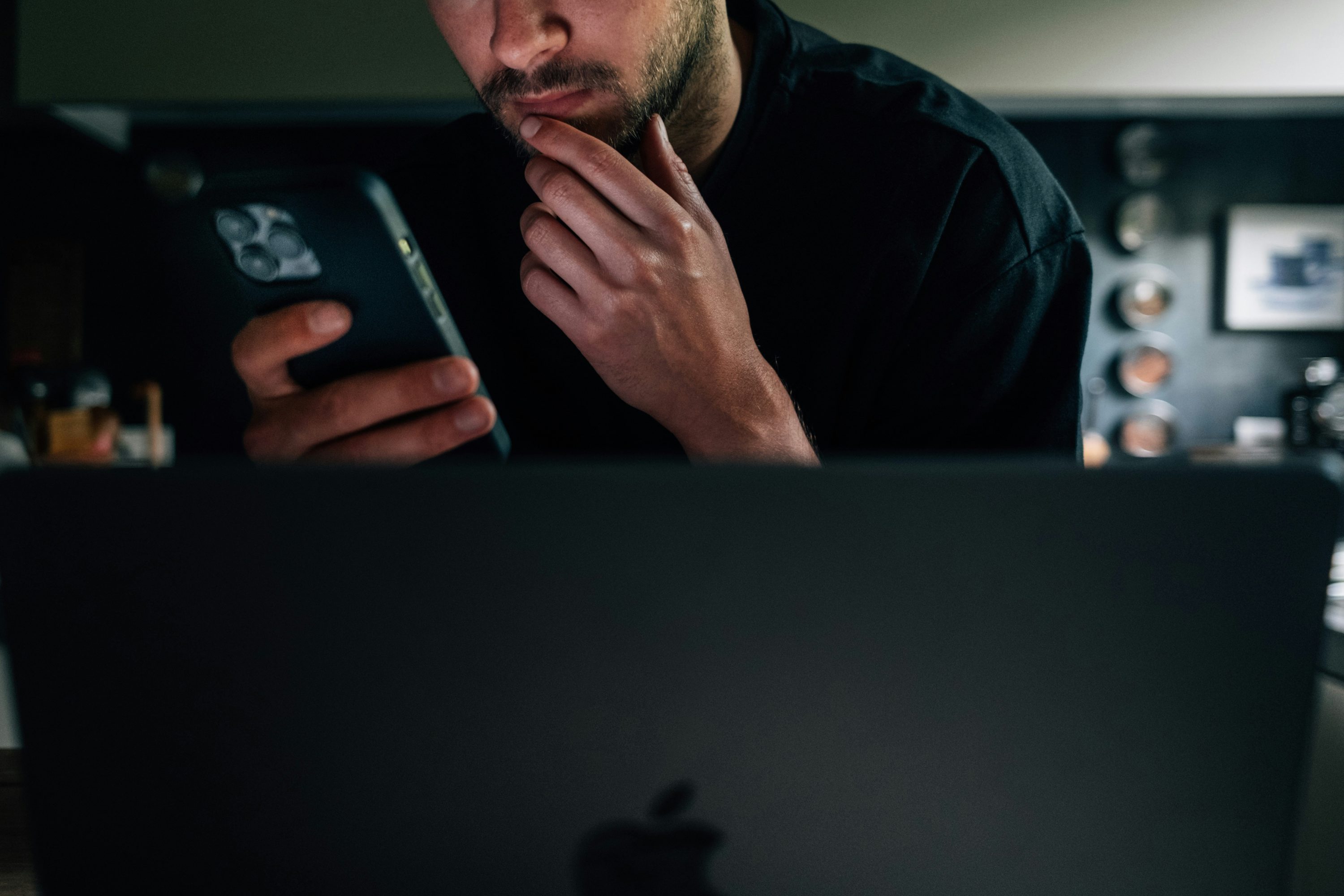
You've probably seen that viral ad from Maybelline, where a train with gigantic eyelashes in the front passes through a huge mascara wand in the New York subway. And you may have thought to yourself, "Wait, did they actually do that?"
The answer is no. It's all Fake Out Of Home advertising!
One of the main reasons FOOH is so popular and works so well now is that it holds an element of surprise and disbelief. When we see something that seems impossible or out of the ordinary, it captures our attention and leaves a lasting impression.
In today's world, where attention is money, that couple of seconds where your audience is left wondering, "Is this real?" would be enough to make them engage and, ultimately, remember your brand.
And no, the Maybelline campaign wasn't just a one-time success. Many other brands, such as Jacquemus, F1, and Samsung, have also successfully used FOOH in their marketing campaigns. If you want to know what these successful FOOH ads did right to create effective and impactful ads, read this article.
As a marketing agency, you can leverage fake out of home advertising to enhance your campaigns and generate value for your clients. Here are three ways you can benefit from using fake out of home advertising:
1. Versatility and testing capabilities: Fake out of home advertising offers endless possibilities for creativity and experimentation. You can place any design or message into your video footage, and if the initial idea doesn't work, you can easily change it as long as it stays within your budget.
Once you’ve cleared the legal guidelines, you can now use any location as a base for your video, whether it's a famous landmark like the Eiffel Tower, a local store, or a Billboard. This is especially helpful when your brand caters to a specific audience.
When working with us, we incorporate legal research in the process.
2. Cost-effective: With fake out of home advertising, you can create the illusion of a large-scale advertising campaign without the high costs. While still requiring a significant investment, FOOH can be a more budget-friendly alternative to traditional OOH solutions at scale, especially for emerging brands or those with limited budgets.
You can reuse your 3D animations, simulations, etc., in different scenes, making it a versatile and cheaper option for running multiple campaigns, maybe even worldwide. The same scene can also be used for other products. If you need to A/B test, which design or message resonates better with your target audience?
No problem. Just adjust the scenes in your video accordingly and see which version performs better! This flexibility can offer significant cost savings for your agency and your clients without compromising the impact of your campaigns.
3. Increased engagement and brand awareness: Because FOOH ads are short-form and attention-grabbing, they are highly shareable and can quickly go viral on social media platforms. The result? Over millions of views, increased brand awareness, and potential new customers for your clients.
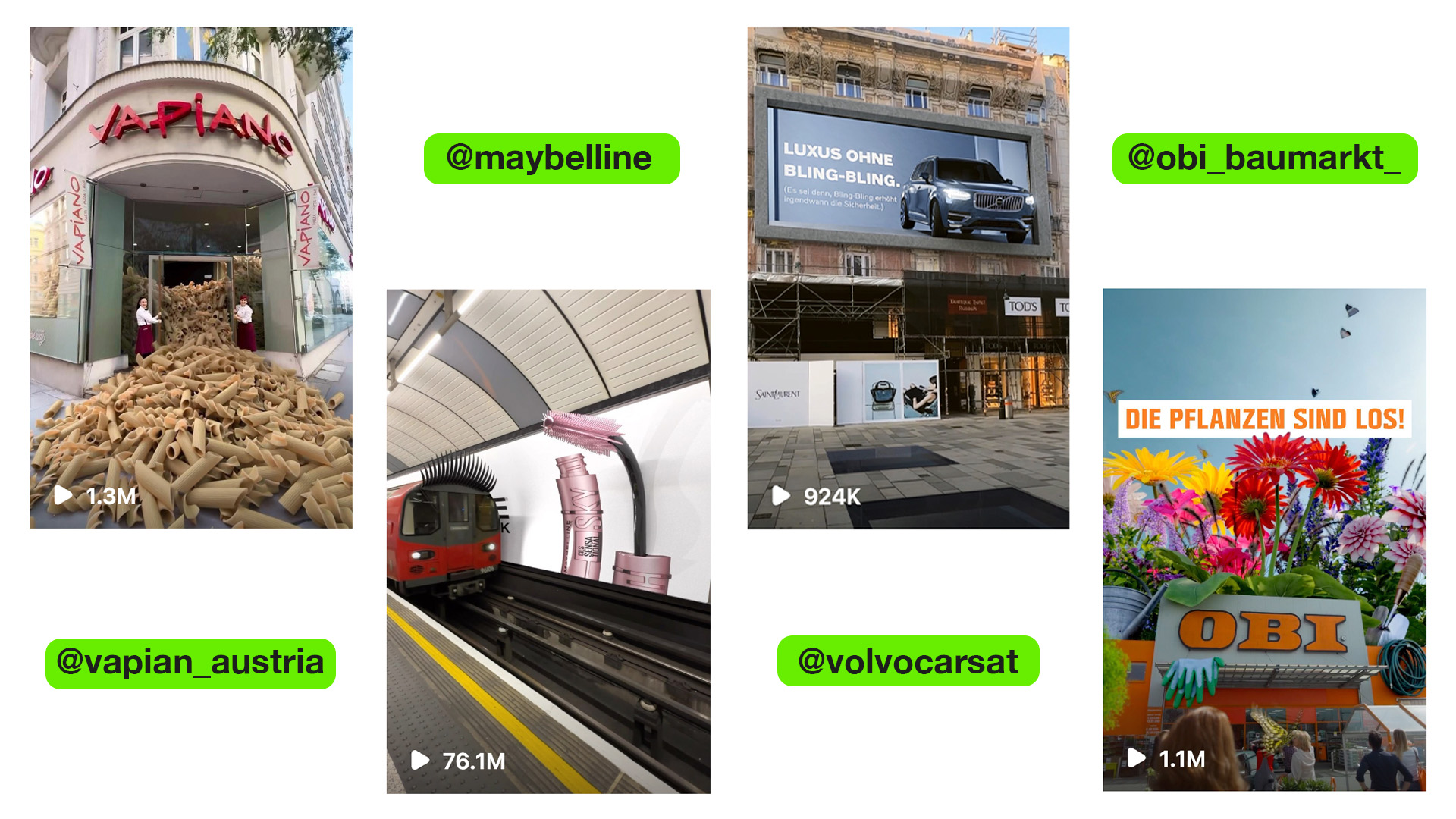
With the rise of short-form content and the increasing competition for consumer attention, fake out of home advertising can be a game-changer for marketing agencies looking to make an impact in today's crowded advertising landscape.
FOOH ads are the new hot thing in the advertising world, and big brands are taking advantage of the opportunity to leverage their power, too. From luxury brands to tech giants, here are some examples of successful fake out of home advertising campaigns by big brands recently:
1. Apple's Pink Pop-Up: In 2023, Apple used FOOH to create a pop-up ad for their new iPhone 15 in the heart of New York. The ad featured an opening shot of someone using the Pink iPhone on a reflective surface, then panning out to reveal a giant glass enclosure with huge pink balls slowly spilling into the streets.
This campaign generated many interactions on social media, with over 7 million views and 4 thousand shares on Instagram. Using a creative and eye-catching FOOH ad like this, Apple successfully marketed its pink (new color) iPhone to its audience and the public.
2. Hugoboss Double B Monogram: To promote their new Double B Monogram collection, Hugoboss used FOOH in Shanghai to project three huge sunglasses with the iconic Double B monogram logo onto a street sign that served as a rotating display.
This campaign garnered over 3 million views on social media, thus increasing brand awareness and driving potential customers to Hugoboss and the new collection.
3. Vapianos Noodels: To promote World Pasta Day, Vapianos used FOOH ads to promote a discount on their pasta dishes. In the ad, the viewer first sees gigantic spaghetti on large pasta drying racks in front of the Vapiano facade.
Panning to the right, two Vapianistas come into the frame and hold the doors to the Vapiano facade open, causing the mountain of pasta inside to pour onto the streets. This campaign received over 2 million views on Instagram, effectively promoting Vapianos and their World Pasta Day deal in locations all over Austria.

One of the primary concerns you'll often encounter when it comes to using fake out of home advertising is how communication can primarily affect the creation of your ad. You're making up something that doesn't exist in the world — which can not just be challenging to produce but to visualize and conceptually communicate as well to others.
Creating a "test video" isn't necessarily ideal, either, as this can be expensive and time-consuming. And if you're running a marketing campaign, you may not always have the luxury to experiment and fine-tune your ad until it's perfect.
To address this issue, we at rendersnek our 3D animation studio prioritizes your idea and vision above everything else. We do this by making your concept as straightforward as possible through visual support, like photo montages, AI image generation, and a clear storyboard or text of what you intend to achieve.
This approach helps eliminate potential misinterpretations and ensures your ad accurately communicates your desired message to your target audience. Knowing how crucial it is to get this right, we'll likely have at least one meeting or call to discuss your project's details and walk you through the creative process.
If you want to know more about our process and how to make viral fake out of home ads, read our article. If you have a question or maybe already have an idea, don’t hesitate to brief us.
The difference between these two already lies in the names themselves. OOH advertising refers to physical advertisements like billboards, posters, and TV commercials.
On the other hand, Fake Out Of Home advertising utilizes computer-generated imagery (CGI) in real video footage, resulting in a typically 10 to 15-second video in a 9:16 FHD Format. In short, a traditional OOH ad is physically present, while you’ll only see fake OOH ads in your social media feeds.
Digital Fake OOH advertising uses CGI, such as 3D animation or just a 3D object, and combines it with real-world video footage. Think of any sci-fi movie where CGI is used to create a realistic explosion in a place like New York—the same concept applies here.
It works by shooting footage in an actual location and then recapturing that scene in a 3D environment. The animation and other elements are then seamlessly tweaked and added; the real-world footage is merged with the CG-Layers to create a realistic and surprising product.
The cost of creating a fake OOH ad can vary depending on the complexity of the final product and the resources needed to produce it.
Factors that can influence the cost include:
- The complexity of the 3D elements, animations & simulations
- Location scouting and permits for filming
- Post-production editing and effects
- Actors necessary
Creating a fake OOH ad, from the initial concept to the final product, can take anywhere from a few weeks to several months. Think of it as a mini-movie production, with all the planning, filming, and editing involved, the more assets needed, the longer it will take.
One single asset with the specs 9:16, 10-15 seconds, and “one shot” is usually done within six weeks when the ideation is final.
Ready to captivate your audience with something genuinely unforgettable or have any ideas you want to bring to life? Contact us, and let's make it happen.
If your ads are no longer getting the retention that you need, you might wish to switch up the way you’re doing things.
That’s what Vapiano CGI Video advert did.
The result?
400,000 views within the first few hours.
And that is what made World Pasta Day a moment to remember!
…
Old-fashioned advertising doesn't work well anymore because technology keeps changing. Brands that want to sell things should work with creative agencies that can keep up with new trends.
In today's fast-paced (advertising) world, capturing and holding a viewer's attention has become an art. It's a skill that demands focus, storytelling, and captivating visuals to keep eyes glued to screens.
So, if you’re wanting 2+ mio. unique views on your next advert, maybe the following insights of our project with Vapiano in collaboration with Traktor Wien agency will help.
In one sentence: Consistently showing up on social media.
Especially as a very young company with little connections in the marketing world, it is not easy to find clients. It’s so competitive that you need something unique. Something that shows you care about the work you do - in our case mostly "Fake Out Of Home Videos".
Our social media tactic: posting once a week, interacting with agencies and brands, try new stuff and not just have a portfolio page.
So, showing up on social media eventually lead, Traktor Wien Agency, whos motto is to do advertising for people who actually don’t like advertising, to our Instagram page and that’s how we ended up getting a good old email in our inbox.
After one or two weeks of DMs sharing ideas, a vision for celebrating World Pasta Day took shape. Vapiano's dream of creating an eye-catching advertisement became a reality.
Challenge 1: Attention
Grabbing attention in the first 1.5 seconds is a known fact to everyone who does social media.
Otherwise, attention is gone, and every click or action associated with it is also gone and of course so is the revenue it brings.
So, to grab the attention in the first place, things needed to happen, a lot of things. At first the viewer can spot the car with a gigantic vapiano take away box on the roof. Then you notice two people walking in from the left side, pointing at the facade, which was filled with hyperdimensional spaghetti.
And last but not least, it’s not enough to grab the attention, you also want to hold it. So as soon as the viewer is done with checking out the façade, the two vapianisti are already opening the double door to reveal an avalanche of penne and fusilli.
Challenge 2: Environment
Since the video was shot in a busier street (almos Mariahilferstraße), we already needed to pick a timeframe where there’s little people, but also where we would have a nice lighting. We checkout the place in different times of the day and decided for the morning between 8:00 am and 9:00 am. Everything seemed perfecet on the day of the shooting, but there is always something that you don’t have influence on. In our case that bulky jeep, that was parked in front of the building. Which was of course not exactly what we wanted when we first started filming.
Whilst it wasn’t ideal, we had to use our surroundings to our advantage and create storyboards based on everything around us – this is how we came up with the gigantic takeaway box infront of the building.
Challenge 3: Food
As already mentioned, the probably biggest challenge was to stage the food in a way, that the viewers first thought isn’t – “yuck, there’s food on the street”.
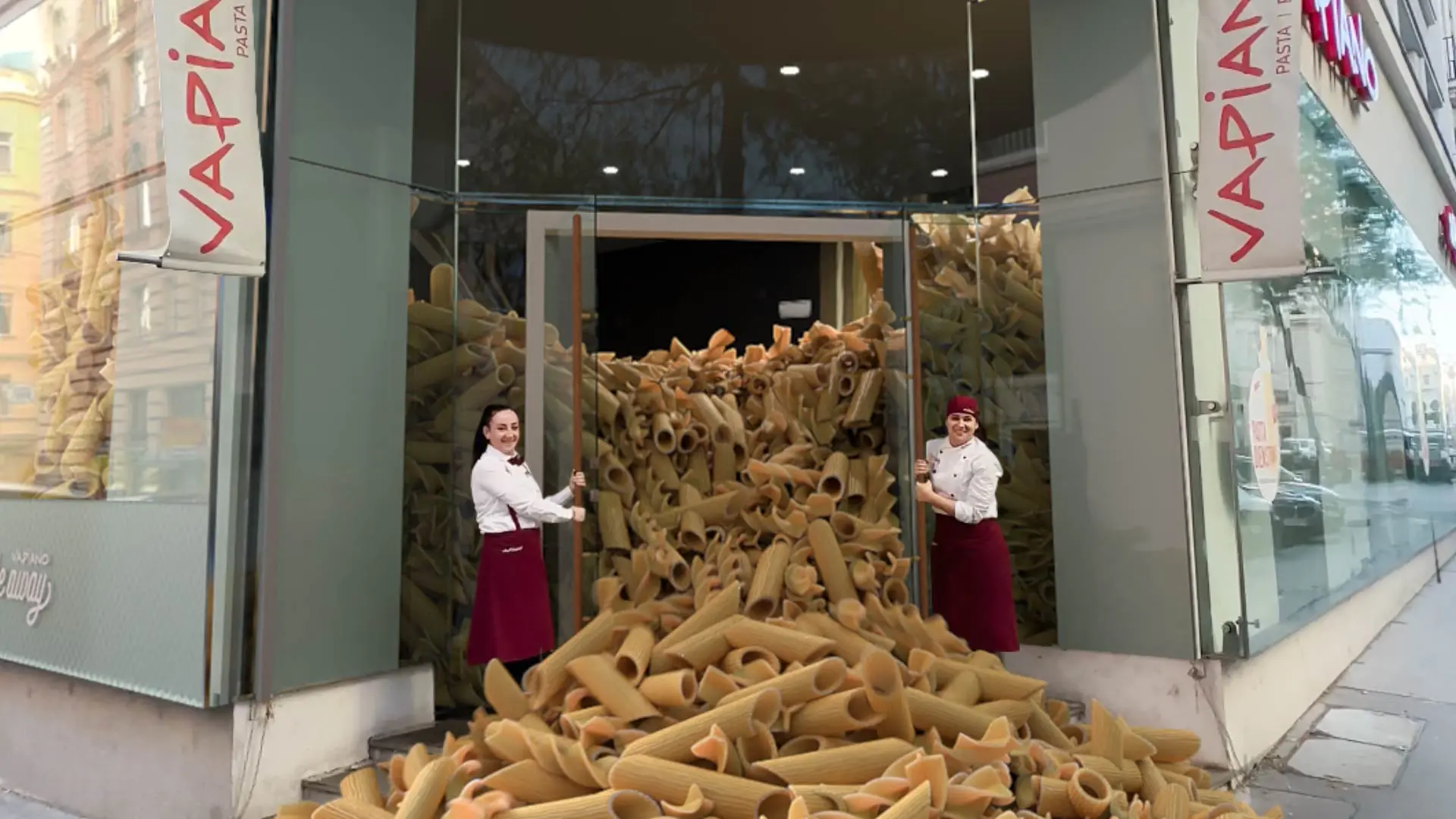
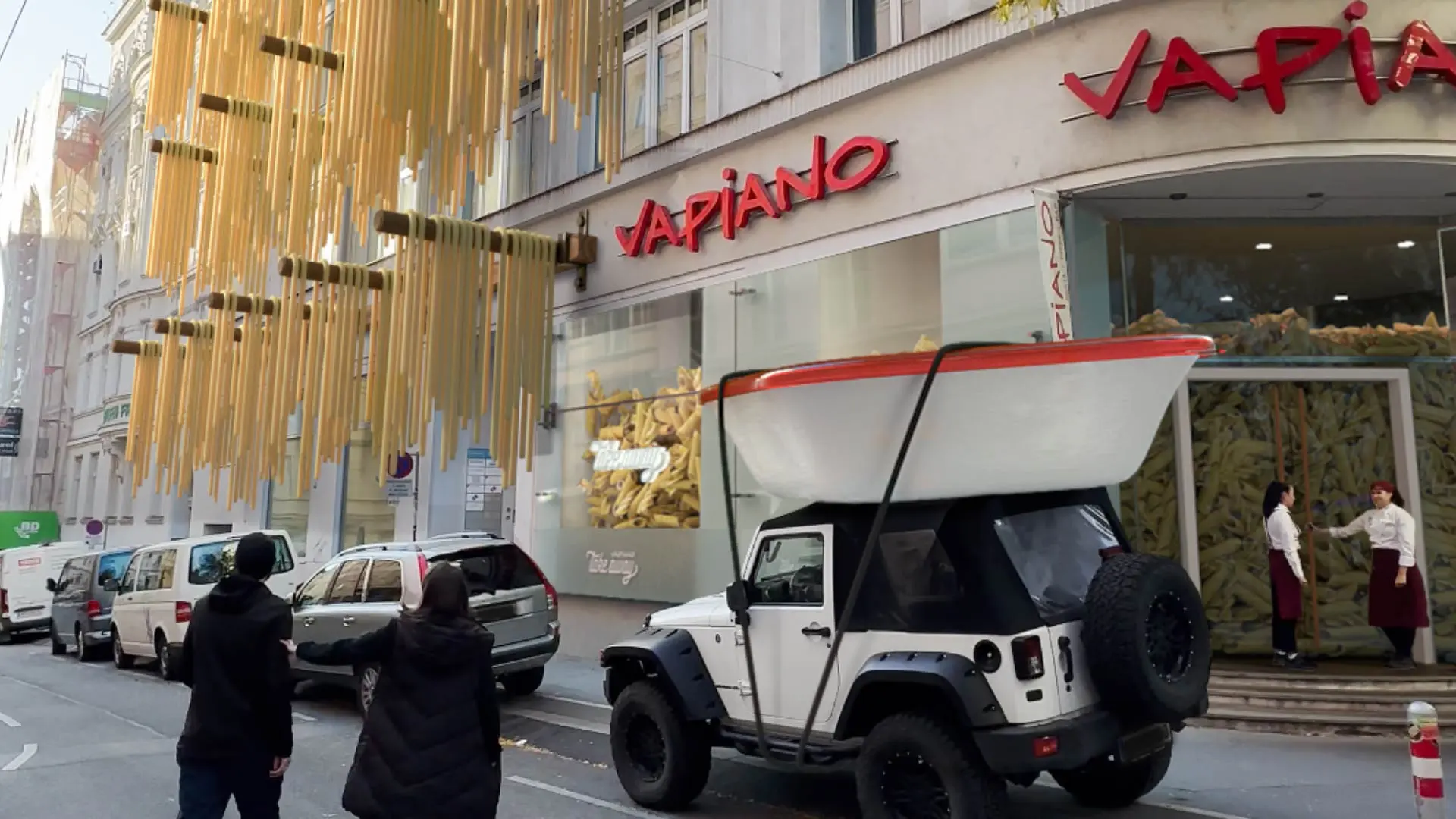
And so, we had to ensure that the fusilli-penne-avalanche simulation looked appetizing, which already was a challenge, because nobody ever saw a pasta avalanche of this size.
Challenge 4: Actors
The last challenge was the human challenge, because when you shoot the video, nothing is there yet. The actors need to understand what will happen in the after production and where everything will be placed. So it’s crucial to have a very detailed idea of what will happen, because you can change pretty much everything in the video, but the reaction of the humas to it is something that can’t be changed.
Our guess is a combination of the many impressions the viewer already has in the first 2 seconds, plus the fact that nobody had ever seen a scene like that before. A fun, entertaining video that invited people to come to the restaurant. It didn’t even feel like an ad.
Rendersnek's collaboration with Traktor Wien Agency for Vapiano's World Pasta Day campaign is a prime example of how CGI can be effectively integrated the advertising industry.
As the world of advertising evolves, standing out becomes crucial. It is understanding what captures attention and keeps viewers engaged that helps to make purchase decisions.
The combination of CGI, reality and attention to detail can turn an everyday scene into a spectacle.
As the lines blur between reality and CGI, this project exemplifies the boundless creativity of the advertising world, turning the ordinary into the extraordinary.